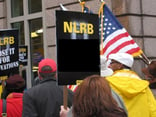On December 19, 2017, the National Labor Relations Board (NLRB) asked the U.S. court of Appeals for the Ninth Circuit to affirm the NLRB’s ruling in Purple Communications, Inc., a 2014 NLRB decision which ruled that employers must presumptively permit “employee use of email for statutorily protected communications on nonworking time.” The ruling applies to those employers who have chosen to give employees access to their email systems, and the presumption of employee rights can be overcome in only very limited circumstances.
Read MoreAudit, Compliance and Risk Blog
NLRB Sends Mixed Signals for Future of Employee Electronic Communications
Posted by Linda Riedemann Norbut on Tue, Mar 20, 2018
Tags: Employer Best Practices, Employee Rights, Internet, NLRB
 Most employers promulgate a wide range of employee-related policies and work rules, which some compile in employment manuals. All too frequently, these policies and work rules contain ambiguities that employees try to parse to understand what rules really apply, and why. What if employees interpret – or might reasonably interpret – an ambiguity in a way that appears to restrict employees’ rights to organize themselves? Do these provisions violate the National Labor Relations Act (NLRA)?
Most employers promulgate a wide range of employee-related policies and work rules, which some compile in employment manuals. All too frequently, these policies and work rules contain ambiguities that employees try to parse to understand what rules really apply, and why. What if employees interpret – or might reasonably interpret – an ambiguity in a way that appears to restrict employees’ rights to organize themselves? Do these provisions violate the National Labor Relations Act (NLRA)?
Tags: Business & Legal, Employer Best Practices, Employee Rights, NLRB, directors, directors & officers
A Cautionary Tale for Employers Drafting Discretionary Bonus Plans
Posted by Jennifer M. Fantini on Tue, Jan 23, 2018
 In the recent British Columbia Supreme Court decision of Kenny v. Weatherhaven Global Resources Ltd., the plaintiff successfully claimed unpaid bonuses and bonus amounts owed over the contractual notice period of approximately $170,000.
In the recent British Columbia Supreme Court decision of Kenny v. Weatherhaven Global Resources Ltd., the plaintiff successfully claimed unpaid bonuses and bonus amounts owed over the contractual notice period of approximately $170,000.
Tags: Employer Best Practices, Employee Rights, Canadian, directors, directors & officers
California’s New Cleaning Products Right to Know Act – A First Look
Posted by Jon Elliott on Tue, Jan 16, 2018
Does your employer’s Hazard Communication program pay attention to cleaning agents used in the workplace – bleaches, disinfectants, glass cleaners, etc? If it does more than mention their existence and note that they’re probably corrosive and maybe toxic, you’re almost certainly in the minority. In most workplaces, workers who use cleaners are exposed to undisclosed or unexplained chemical hazards. And even if your organization’s employees do receive this information, does your employer contract out janitorial and other service work without ensuring that those night janitors are fully trained and protected?
Read MoreTags: Business & Legal, Employer Best Practices, Employee Rights, Environmental risks, Environmental, Hazcom
If someone receives occupational direction and/or compensation from more than one entity, then who’s the boss? Sometimes it’s obviously one or the other, sometimes it’s not clear which one is, and sometimes the answer may be “both.” The answer has important implications, not just for who writes a paycheck but for who is subject to legal requirements and prohibitions under federal, state and local laws. The National Labor Relations Board (NLRB) upended established definitions in 2015, in a decision that Browning-Ferris Industries of California (BFI) was a joint employer with the company (Leadpoint Business Services) that provided employees who worked at one of BFI’s sanitary landfills, since BFI reserved the right to intervene in a variety of labor decisions. By a party-line 3:2 vote (with Democrats in the majority) NLRB “restated” agency and judicial precedent and found that the two companies were indeed joint employers, which realigned the employees’ access to collective bargaining (NLRB’s area of jurisdiction). The other two members dissented vociferously, for a variety of reasons.
After the BFI decision, employer groups and many Republican legislators argued that the correct standard was actual control not potential control, and that the majority was abandoning the common law approaches it claimed to follow. Early in December 2017, the U.S. House of Representatives passed legislation to write a definition of “joint employer” into the National Labor Relations Act (NLRA), in order to reverse this expansive interpretation (HR 3441, the “Save Local Business Act”). However, on December 14 the NLRB – now with a 3:2 Republican majority after President Trump filled two intervening vacancies – voted on a party line vote to rescind the BFI case analysis and return to an actual control test. The new decision is in Hy-Brand Industrial Contractors, Ltd. and Brandt Construction Co., as a single employer and/or joint employers. The remainder of this note discusses the issue and this decision, which probably resolves the issue … until the next election that changes the balance of power again.
Who Can Be a “Joint Employer” Under the NLRA?
The NLRA does not presently include a statutory definition of “joint employer” (or even “employer”, for that matter, other than to clarify that “any person acting as an agent of an employer” is also considered an employer (29 USC § 152(2))). In the absence of a statutory definition, NLRB and courts look to other labor laws and the “common law” when considering whether an employer-employee relationship exists. This case-specific review allows flexibility to adapt policies to changing workplace realities, but also means that guidance can be unclear and tends to vary with the opinions of a majority of the five NLRB Board members.
Read MoreTags: Business & Legal, Employer Best Practices, Employee Rights, NLRB
Highly-publicized revelations about extensive workplace harassment have cost many alleged harassers their high-powered positions (including US Senator Al Franken), and are producing a variety of proposals to toughen standards. One of the first new provisions was enacted by the U.S. Senate on November 9. The Senate Anti-Harassment Training Resolution of 2017 (S.Res. 330) will require anti-harassment training in Senate offices. The Resolution applies to internal governance of the Senate, so does not apply to any other body, such as the House of Representatives (where House Resolution 630, requiring annual training by each member, officer and employee in employee rights, including anti-harassment and anti-discrimination, was passed on November 29 but is being reconsidered).
Read MoreTags: Business & Legal, Employer Best Practices, Employee Rights, Workplace violence
“Workplace” Under Part II of the Canada Labour Code Includes Work Activities Performed in Workplaces Not Controlled by the Employer
Posted by Maryse Tremblay on Tue, Oct 17, 2017
In a recent decision, Canadian Union of Postal Workers v. Canada Post Corporation, the Federal Court of Appeal reversed an earlier Federal Court endorsement of an appeals officer’s decision to limit the definition of “workplace” for the purposes of inspection under Part II of the Canada Labour Code to workplaces where the employer exercises control.
Read MoreTags: Employer Best Practices, Health & Safety, Employee Rights, Canadian
Major Changes to Ontario’s Employment and Labour Laws Pending
Posted by STP Editorial Team on Tue, Jul 25, 2017
On May 30, 2017, the Ontario government announced its intention to introduce The Fair Workplaces, Better Jobs Act, 2017. This legislation would include significant amendments to the Employment Standards Act, 2000 (ESA) and the Labour Relations Act, 1995 (LRA).
Read MoreNew California Guidance For Workplace Anti-Harassment Efforts
Posted by Jon Elliott on Tue, Jun 27, 2017
Last year, the state Department of Fair Employment and Housing (DFEH) adopted a requirement that employers with five or more employees create detailed written policies for preventing harassment, discrimination, and retaliation. This month, DFEH issued detailed guidance addressing these anti-harassment requirements. These new guidelines should be required reading for California employers, and non-California employers should take the opportunity to compare their own efforts against these recommended best practices.
What Are California’s Harassment Prevention Requirements?
Effective April 1, 2016, DFEH regulations require California employers with five or more employees to create detailed written policies for preventing harassment, discrimination, and retaliation. DFEH claims finds authority for this requirement in the state Fair Employment and Housing Act (FEHA) prohibitions against discrimination, harassment and retaliation, and in FEHA’s requirement that employers “take reasonable
steps to prevent and correct wrongful (harassing, discriminatory, retaliatory) behavior in the workplace.”
Anti-harassment policies must do all of the following:
Tags: Employer Best Practices, Employee Rights, California Legislation, Workplace violence
Thinking About Occupational Hearing Protection After Better Hearing and Speech Month
Posted by Jon Elliott on Thu, Jun 22, 2017
May was Better Hearing and Speech Month, and the National Institute for Occupational Safety and Health (NIOSH reminded employers that Occupational hearing loss (OHL) is one of the most common work-related illnesses in the United States. Each year, about 22 million U.S. workers are exposed to hazardous noise levels at work. NIOSH reports that U.S. employers paid more than $1.5 million in penalties for not protecting workers from noise in 2016, and that $242 million is spent annually on workers' compensation for hearing loss disability.
Read MoreTags: Employer Best Practices, Health & Safety, OSHA, Employee Rights








